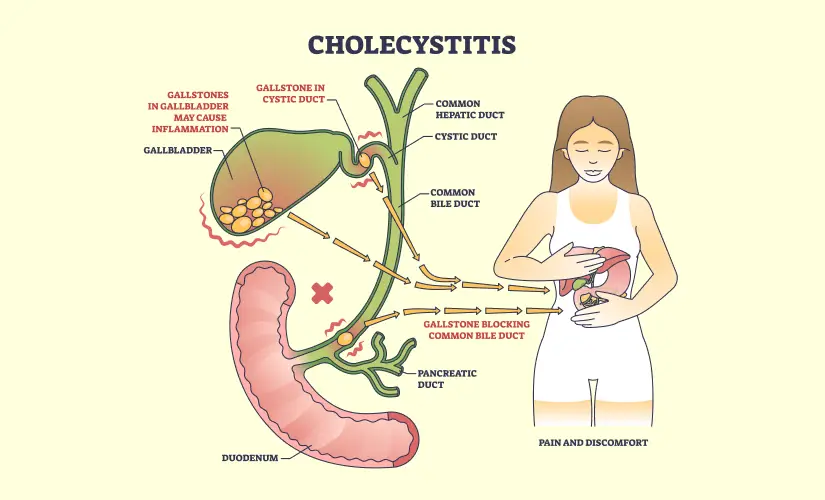Cholecystitis, a medical condition characterized by inflammation of the gallbladder, can present as either acute or chronic. This condition, often associated with gallstones, requires prompt diagnosis and effective management to prevent complications. Below, we delve into the causes, symptoms, diagnostic methods, treatment options, and prevention strategies.

Understanding Cholecystitis
What is Cholecystitis?
Cholecystitis refers to inflammation of the gallbladder, a small organ located beneath the liver that stores and releases bile to aid in digestion. The condition can manifest as:
- Acute Cholecystitis: A sudden and severe inflammation, often caused by gallstones obstructing the cystic duct.
- Chronic Cholecystitis: Recurrent or prolonged inflammation due to repeated episodes of biliary colic or ongoing irritation.
Causes of Cholecystitis
The primary causes of cholecystitis include:
- Gallstones (Cholelithiasis): Blockage of the cystic duct by gallstones is the most common cause.
- Biliary Sludge: Thickened bile can lead to obstruction and subsequent inflammation.
- Acalculous Cholecystitis: Inflammation without gallstones, often seen in critically ill patients.
- Infections: Bacterial infections, such as those caused by Escherichia coli, Klebsiella, or Enterococcus species, can exacerbate inflammation.
- Tumors: Rarely, tumors obstructing the bile ducts can cause cholecystitis.
Recognizing the Symptoms
Acute Cholecystitis Symptoms
- Severe pain in the upper right abdomen or right shoulder, often lasting several hours
- Fever and chills
- Nausea and vomiting
- Tenderness over the gallbladder (Murphy’s sign)
- Jaundice in some cases
Chronic Cholecystitis Symptoms
- Intermittent abdominal pain (biliary colic)
- Indigestion
- Nausea, particularly after fatty meals
- Mild tenderness in the upper right abdomen
Diagnostic Approach
Clinical Evaluation
Physicians often begin with a detailed history and physical examination, focusing on symptoms and risk factors such as obesity, female gender, and age over 40.
Imaging Studies
- Ultrasound: The first-line imaging modality to detect gallstones, thickened gallbladder walls, or pericholecystic fluid.
- HIDA Scan (Hepatobiliary Iminodiacetic Acid Scan): Used to assess bile flow and cystic duct obstruction.
- CT Scan: Provides detailed imaging to rule out complications like abscesses or perforations.
- MRI/MRCP (Magnetic Resonance Cholangiopancreatography): Identifies biliary tract obstructions or stones.
Laboratory Tests
- Complete Blood Count (CBC): Elevated white blood cell count suggests infection.
- Liver Function Tests (LFTs): May indicate biliary obstruction.
- C-Reactive Protein (CRP): Elevated levels indicate inflammation.
- Amylase and Lipase: To rule out pancreatitis.
Treatment Options
Acute Management
- Hospitalization: Most patients require admission for monitoring and treatment.
- Fasting (NPO): To rest the gastrointestinal system.
- Intravenous (IV) Fluids: To maintain hydration.
- Antibiotics: Broad-spectrum antibiotics targeting gram-negative and anaerobic bacteria, such as piperacillin-tazobactam or ceftriaxone with metronidazole.
- Pain Management: Nonsteroidal anti-inflammatory drugs (NSAIDs) or opioids for severe pain.
- Cholecystectomy: Surgical removal of the gallbladder is the definitive treatment. It can be performed laparoscopically or via open surgery.
Chronic Cholecystitis Treatment
Elective cholecystectomy is the standard approach to prevent recurrent episodes and complications.
Non-Surgical Alternatives
- Endoscopic Retrograde Cholangiopancreatography (ERCP): To remove stones from the bile ducts.
- Percutaneous Cholecystostomy: For high-risk patients who cannot undergo surgery.
Complications of Untreated Cholecystitis
- Gallbladder Rupture: Leading to peritonitis.
- Empyema: Pus accumulation within the gallbladder.
- Gangrenous Cholecystitis: Tissue death due to poor blood supply.
- Fistula Formation: Abnormal connections between the gallbladder and other organs.
Prevention Strategies
- Healthy Diet: Avoid high-fat foods and consume a balanced diet rich in fiber.
- Maintain a Healthy Weight: Obesity increases the risk of gallstone formation.
- Regular Exercise: Physical activity supports overall digestive health.
- Medications: In some cases, medications like ursodeoxycholic acid may be prescribed to dissolve small gallstones.
- Routine Health Checks: Early detection of gallstones can prevent complications.